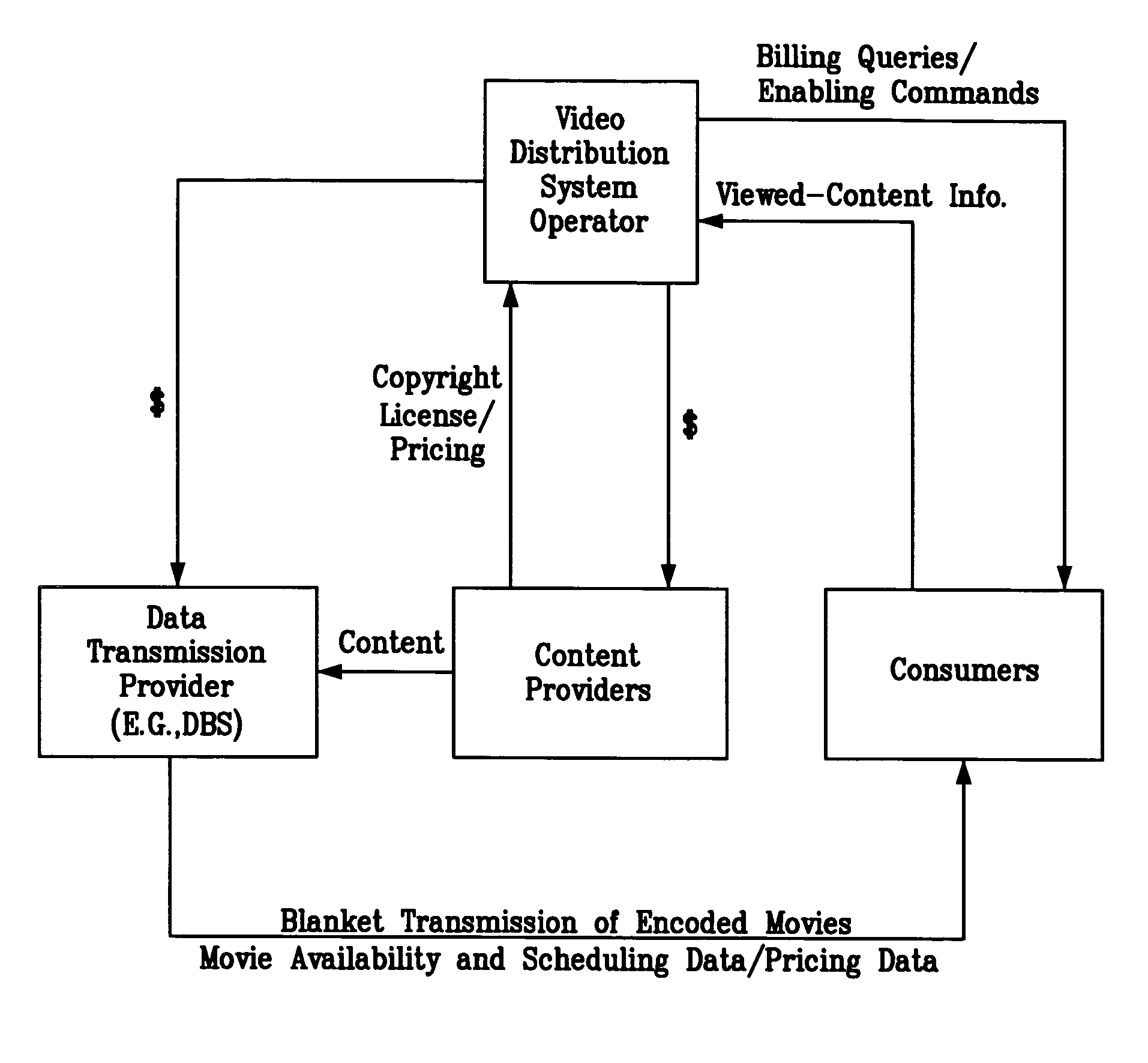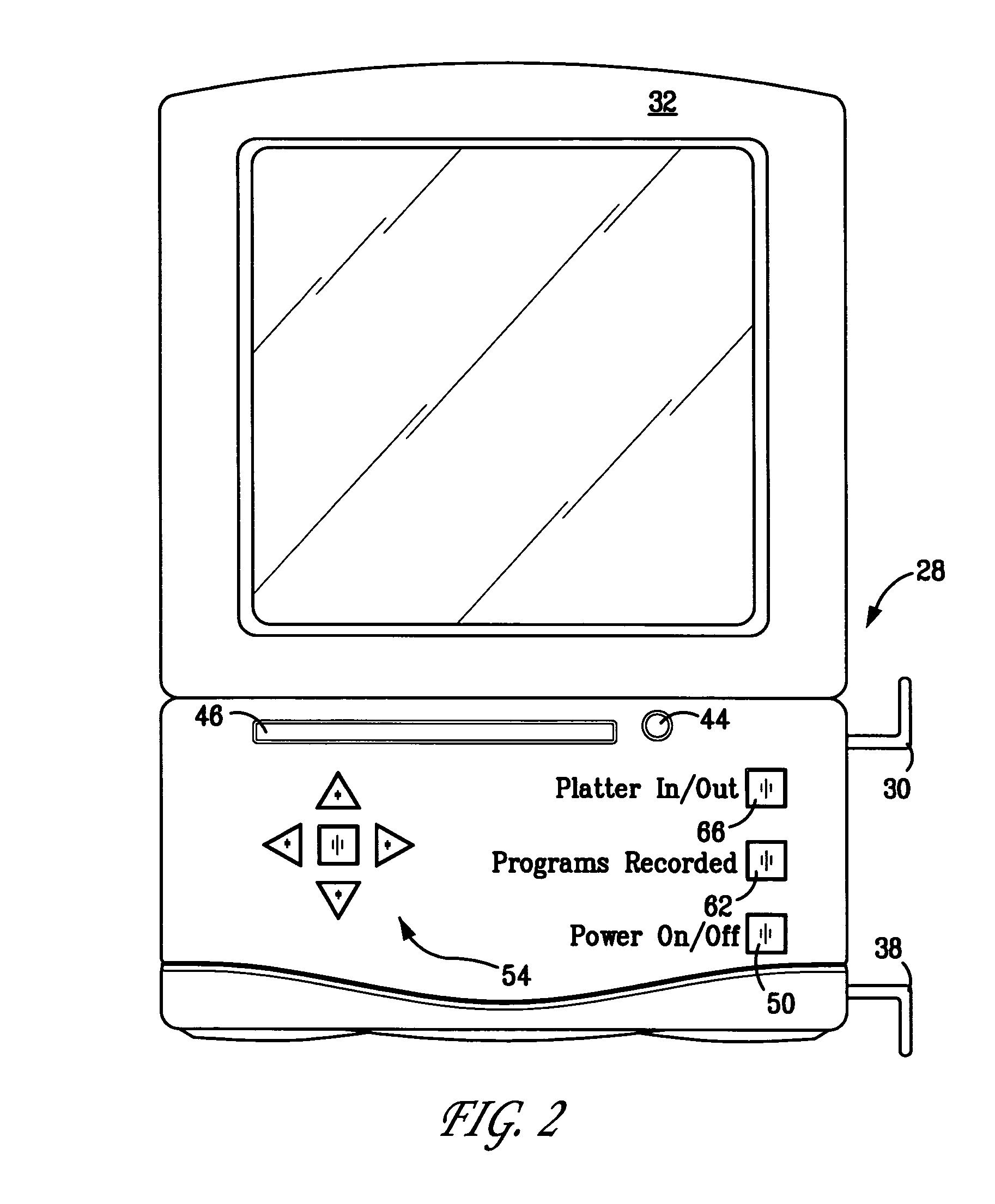[0011] The present invention provides a video
distribution system that is beneficial to all involved parties, namely consumers, content providers and
data transmission providers. In preferred embodiments, consumers are able to preselect movies for viewing from as many as one to eight thousand movies or more that are transmitted daily and as many as ten to sixty thousand movies or more transmitted monthly. Customers of the video
distribution system utilize a menu driven,
graphical user interface with simplified controls that provide movie selection by title, type, category (e.g., comedy new releases from major studios). In preferred embodiments, video / audio content is
blanket transmitted via
direct broadcast satellite (DBS) in an encoded, compressed form for playback at VHS resolution (or other desired resolution). The transmission is directly to each customer's receiving dish or antenna which is linked to the customer's user
station where selected movies are stored on
DVD RAM discs or CD's in a multiple disc platter, or on a hard drive having a storage capacity of, for example, 20 gigabytes or more. The movies may then be played immediately or at any time desired by the
consumer, with the
consumer paying for only those movies that are viewed. Preferably, the movies are encoded to prevent conversion and duplication for play on existing DVD, CD or other systems. The encoding technology also prevents playback on user stations of the video
distribution system in homes that are not current on payments for previous purchases. In certain embodiments, the encoding system includes a novel time-based encoding technology, and movies may be watermarked so that copies are traceable to the customer site.
[0012] The video distribution system of the present invention offers numerous advantages to consumers. For example, consumers have access to new movie releases at those times dictated by
market conditions to be most favorable by the content providers and the distributors, often before the movies would be available at video rental stores. Consumers will pay for a movie only after it has been viewed, not when recorded. Thus, consumers are free to
record categories or classes of movies (e.g., new releases) and later make a decision as to which movies to actually view—paying only for those that are viewed. In certain embodiments, consumers have access to movies that are automatically recorded, such as popular new release movies and movies that are being promoted by the content provider and / or system operator. Consumers may view the videos at any time without restraints related to
broadcasting schedules and with no need to visit a video rental store for selection of the movie or returning the movie. There are no late fees. New movie releases will never be “sold out” as they frequently are in existing video rental stores. Another
advantage to consumers is the ultimate lower cost occasioned by the system's
elimination of the real estate and labor costs associated with existing video rental stores. Because literally thousands of movies are available on a daily / weekly / monthly basis, the video distribution system of the invention provides a much greater selection than any existing video rental store. The invention also provides full access to content for those who live in geographically remote and / or sparsely populated areas that may presently have little or no access to video rental stores. The invention also allows access to videos for families with young children, elderly persons and handicapped persons where theater viewing and round trips to video rental stores are inconvenient, prohibitive or expensive. Each user
station utilizes high capacity storage such as DVD platters or hard drives for its read / write functions in addition to an
operating system that provides greatly simplified on-screen
programming. The present invention also provides the ability to update movie pricing at any time, for example on a daily, weekly or monthly basis, so that consumers can choose to view movies at times when content providers offer pricing specials or incentives. When a movie is recorded on a disc, it can be labeled and stored for future play or, depending upon the storage medium, recorded over (similar to a blank VCR tape). As new movies are recorded and shelved, new or previously used videos can be inserted into the platter for future recording.
Video quality is improved over existing video rentals where, in most cases, available tapes have been degraded by previous play.
[0013] Content providers (e.g., major
studio producers) recognize a very significant benefit in that they receive income every time a movie is played, thereby creating significant
residual value for their investments. Importantly, new release movies are always available (i.e., not “sold out”) during initial
peak demand when pricing power is the highest. The mentioned
residual value translates into increased income for the content providers because a significant portion of existing content is available for sale every day—since thousands of movies are transmitted on a daily / weekly / monthly basis. The invention also allows content providers to change pricing at any time, e.g., daily / weekly / monthly, to optimize price vs.
consumer demand. In this regard, content providers are allowed to meet
consumer demand for a significant portion of the existing content inventory value every day. This provides an extremely high benefit by effectively allowing the market to clear (i.e., real demand matches supply), something that the current video
distribution model (TV, movie channels, pay-per-view and video rental) do not provide. Additionally, content providers may download preview material that is specific to user profiles.
[0014] According to the invention, content providers are confident that they can distribute their movies with extremely
high security through the use of appropriate encoding technology. Preferably, the encoding includes time-based encoding technology, with new code keys for every distributed movie transmitted via phone / modem with billing queries every month. Time-based coding, in combination with a single standard proprietary
operating system, allows the video distribution system operator to achieve the level of security demanded by content providers. Watermarks coded to each site may be placed in any playback
signal to assure that movie copies, even those made by recording at the input to the TV or monitor can be traced to a specific site or purchase.
[0015] Transmission providers (DBS
satellite system providers, in preferred embodiments) realize the
advantage of a significantly increased income base for supporting their services and the utilization of lower cost, off-peak time for transmission of a significant portion of the movies, as well as opportunities to market other products and services to specific customer profiles.
 Login to View More
Login to View More  Login to View More
Login to View More 


